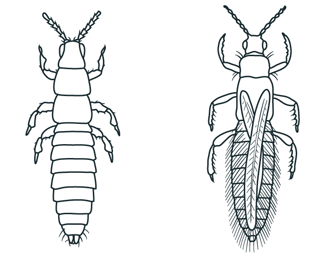
 |
|
Hydroponics - Indoor HorticultureHydroponics - Indoor Horticulture represents an educational, in-depth,
up-to-date,
indoor horticultural growers guide that covers all principles of indoor Hydroponics - Indoor Horticulture examines, explores, dissects and
presents a fully comprehensive step by step growers guide, relating
to all and every aspect of indoor hydroponic horticulture, with complete
chapters on plant biology, propagation, hydroponic systems, nutrients,
oxygen, carbon dioxide enrichment, pH, biological pest control, fungi/disease,
cuttings/clones, pruning/training, breeding, harvesting, equipment,
grow rooms, a full history of hydroponics, and more. |
(Below
follows a one page sample taken from the book) Thrips (Thunderflies)Thrips are small, slender insects which measure about 2-3 mm long when mature. On adults, two pairs of narrow wings fringed with long hairs are visible and when at rest, the wings are laid along the back. Their colour depends on the species, but these can range from a pale yellow through to a greyish yellow-brown to black. In order to establish characteristics which distinguish the different species, magnification is required. Recently, new species have been introduced from abroad and can be potentially damaging pests, such as Western Flower thrips, Glasshouse Banded thrips and Palm thrips. Thrips like company and usually appear in large numbers on leaves or flowers.  Example of Thrips - Nymph (left) and Adult (right)
Example of Thrips - Nymph (left) and Adult (right)
Preferred Host PlantsMany C3 plants, crops and ornamentals can succumb to infestation, most frequently on cucumbers and flowering plants. DiagnosisThrips suck sap by puncturing leaves or flower buds with their mouthparts, and the affected parts become blotched or flecked and dry out. In very acute cases, the plants appear to have been burned. When leaves or buds swell, they can become contorted or torn, and form windows in the tissue. The thrips are visible, usually in large numbers, near the veins on the undersides of leaves. Life CycleA female can produce approximately 60 eggs during |
the course of a season.
Eggs are deposited on the undersides of leaves, protruding from a tiny
cut in the plant tissues. The larval stage is about 10-14 days in the
case of the common Tobacco thrips, whereupon the larva drops to the ground
and tunnels into the growing medium to pupate there. Reaching the adult
stage takes another 4-7 days. Thrips are quite vulnerable to insecticides,
but can be quite awkward when other biological control agents have been
used and this prevents chemical control. Fumigation between crops can
be a useful remedy, but pesticide residues can remain for some considerable
time and prohibit future use of biological control in the grow room.
Biological Pest ControlAmblyseius Mackenziei and A. Cucumeris Both species of amblyseius are small predatory mites approximately 1 mm in length with slightly flattened bodies which are pear-shaped. They are a pale brown colour. They are very energetic and scatter over a wide area. Their white eggs can sometimes be seen attached to plant hairs. Life CycleAmblyseius have quite a long lifespan, and can produce several eggs a day. Both adults and young mites will eat thrips. They can also eat bugs other than thrips, for example, young spider mites, so they can survive even if the thrips population has been diminished. ProcedureAmblyseius are sent out as mobile mites that are mixed with bran. This is sprinkled over infested crops. Now available are small sachets that contain bran and mites which can be hung among the plants where the mites then scatter. These sachets also contain enough food for the amblyseius to survive should food be in short supply, or if they are introduced before the thrip population has multiplied enough. These sachets are sometimes called ‘breeder’ or ‘grower’ packs. Amblyseius are not particularly fond of low humidity, and lengthy, dry and hot spells can cause their numbers to reduce quite significantly. Damping down or misting during these hot periods can be beneficial. These sachets should be placed out of direct light and away from heat sources. |
|
 |